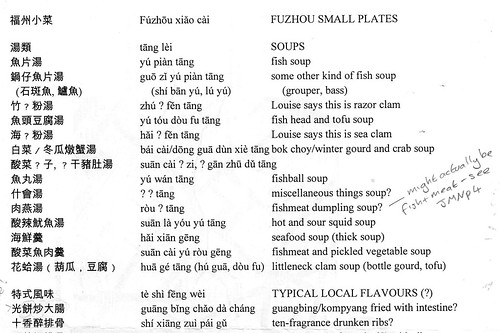Reading Chinese Menus: Concepts: The restaurant cheat-sheet
[Image: A printed sheet of paper with three columns containing names of Chinese dishes: first in Chinese characters, then in pinyin, then in English. Some of the Chinese characters are missing, replaced by question marks to indicate that I couldn't figure them out. Some of the English translations are followed by question marks to indicate that they're tentative.]
OK, so I've taken a couple of weeks to get going again since I mentioned that I'm cutting back to posting just once a week, but here goes with the new regime. I'll probably aim to post mid-week, Tuesday or Wednesday.
Today's concept is the restaurant cheat-sheet, an example of which is pictured above. This is how I deal with ordering from a Chinese-only menu when I've organised a meal out with a group of people who don't read any Chinese. I acquire the menu in advance, then transcribe it, attempt to translate it, print off a few copies of my translation, and bring them along with me on the evening. Then we can all take a look at the menu and see what looks interesting.
As can be seen above, my translations are often incomplete (though this is a fairly difficult menu in comparison to most I've seen in London). It also obviously doesn't help with restaurants where I've not been able to see the menu in advance. But it's a technique I've found quite helpful, so I thought I'd share it.
As for the amount of work involved; yes, there is some, but it's work that's useful in more than one way. I've posted before about the importance of daily practice. One of the things I try to do every day is a little bit of transcribing, and even with just five minutes spent on this every day, the task is soon done.


Re: Chinese menus
I do have a few Chinese friends, and some of them can read Chinese. In fact, since I made the cheat-sheet pictured above, one of them helped me identify one of the missing characters; I just wanted to show a picture of a cheat-sheet with scribbles on, so I didn't make a fresh one.
There are quite a few handwriting recognition tools available on the web — you don't need an iPad or iPhone (I also don't have either). I use the one at ChineseTools.com. Once you get used to recognising radicals, looking things up by radical (e.g. on CantoDict) can help too.
The tricky thing about the menu transcribed above (here's a photo of the actual menu) is that it uses a few characters that seem to be omitted from many dictionaries (e.g. 蛏/chēng), so handwriting recognition didn't help in this case.